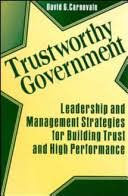 (Reprinted with permission from American Political Science Review, written by Frank J. Thomas.)
(Reprinted with permission from American Political Science Review, written by Frank J. Thomas.)
Potential readers of David G. Carnevale’s Trustworthy Government: Leadership and Management Strategies for Building Trust and High Performance should from the start be aware of two of its characteristics. First, the volume does not focus on trustworthy government in the broadest sense. Instead, it zeroes in on trust within organizations as the central problem that must be solved to achieve better performance by public agencies. Second, the tone of the book is hortatory. Carnevale mingles his review of the literature on organizational trust with strong convictions that government agencies face major deficits of trust brought on by an outmoded commitment to the bureaucratic model.
These features acknowledged, the book deserves serious attention by those interested in public administration, organizational theory, and, more generally, opportunities to enhance the performance of governmental institutions. At a time when many scholars have become attracted to the principal-agent model, with its emphasis on the need to control underlings who will shirk, distort information, and engage in other wayward behavior, a book that hammers home the importance of internal organizational trust is welcome indeed.
In the first part of the volume, Carnevale makes a strong case that trust is the “hidden ingredient” in high-performance agencies. He reviews various definitions of trust, summarizing it finally “as faith or confidence in the intentions and actions of a person or group to be ethical, fair, and nonthreatening concerning the rights and interests of others in social exchange relationships.” Carnevale contends that low-trust organizations suffer from many impediments to higher performance. Above all, they fuel fear, defensive routines, and related dynamics that block employees from continuous learning.
In the second part of the book, Carnevale conducts a workmanlike review of certain keys to building trustworthy organizations. In this regard, he shines his spotlight on strategies for leadership, employee participation and involvement, effective communication, equitable performance appraisal and incentive systems, and the sensible management of power, politics, and conflict within organizations. These chapters draw from a substantial body of literature—especially that focused on organizational behavior and development—to etch a more detailed vision of a high-trust agency.
The third section of the book calls for “liberating public organizations” by “transcending the bureaucratic machine.” This section opens with an excellent chapter on reinventing training in order to achieve a new learning paradigm for organizations that encourages employees to think critically, to learn on their own, and to use what they know. Carnevale concludes this section with a call for “democratic administration”—a form of administration that, among other things, facilitates trust by providing employees with abundant opportunities for meaningful involvement in agency decisions.
The hortatory, provocative style of Trustworthy Government will no doubt stiffen the backs of some who read it. But Carnevale’s fundamental thesis is sound and the volume takes the reader beyond the conventional wisdom on how to improve the performance of public agencies. Others have recognized the importance of organizational trust, but Carnevale pushes the concept to center stage in the current debate about revitalizing public management.
Moreover, Carnevale’s work points to an agenda for additional research on issues of trust within public organizations. How can we better conceptualize and measure trust? To what degree do different kinds of public-sector agencies experience low levels of trust? How do these levels compare with those in the private sector? How strong is the relationship between lower scores on measures of internal organizational trust and higher rankings on indices of bureaucratization?
Even more fundamentally, the book suggests the need to wrestle with the important problem of whether high-trust public agencies can thrive in low-trust societies. In this regard, much evidence indicates that citizens’ trust in government in the United States has slumped over the last three decades. People harbor skepticism about an array of other institutions and about each other. If this depletion of social capital is in fact occurring, it poses profound problems for those seeking to create high-trust learning agencies in government. A low-trust society will, for instance, fuel tendencies to heap more and more rules and controls on administrative agencies that will in turn erode their capacity and competence.
Ultimately, we need to learn much more about the particular circumstances under which governments can foster high-trust public agencies in a low-trust society. As part of this inquiry, we should probe which leadership and management strategies are hearty enough to be effective in such a corrosive environment. David Carnevale deserves much credit for forging a bridgehead from which to explore these and related issues.
Appetizer
Trust is an expression of faith and confidence that a person or an institution will be fair, reliable, ethical, competent, and nonthreatening. In the world of work, there is a pervasive “trust gap,” and it is widening. Many Americans go to their jobs with guarded, suspicious, and cynical attitudes. They have lost faith in their organizations. Their hopes and expectations have been mismanaged. The costs of mistrust and cynicism are high. These emotions corrode organizations and destroy high performance. The loss of trust is a loss of system power in organizations. Trust is an integrative mechanism—the cohesion that makes it possible for organizations to accomplish extraordinary things. Trust is social capital. It reduces conflict, improves communication, eases cooperation, enhances problem solving, reduces stress, enables people to realize more satisfactory relationships, amplifies organizational learning, and advances change. Trust is a positive mind set. It needs to be restored in organizations.
—from Trustworthy Government